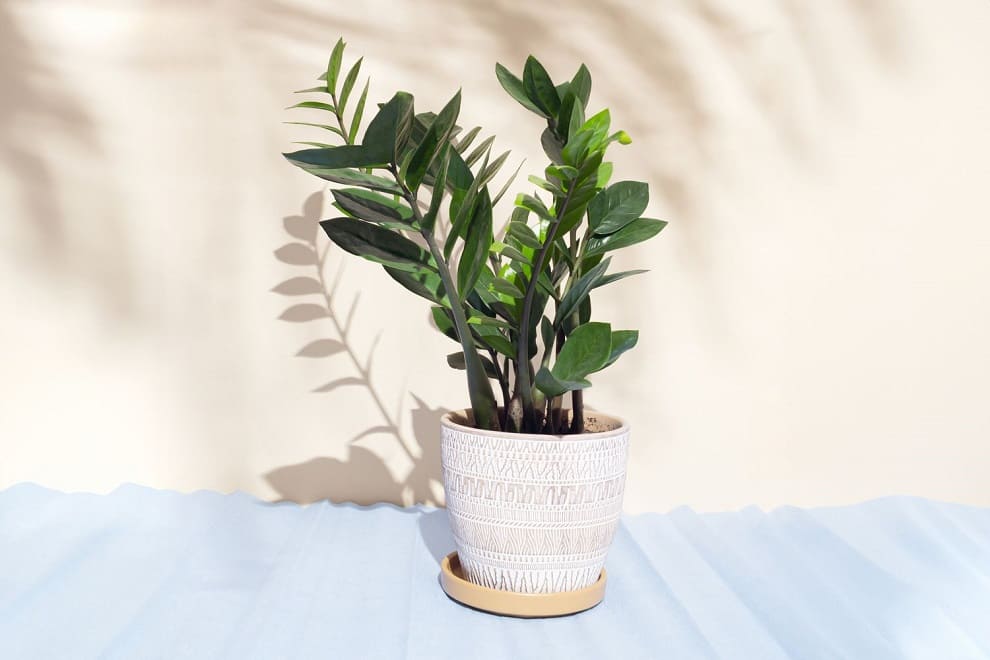A few years ago, I walked into a friend’s dimly lit apartment and was struck by a stunning plant sitting confidently in a corner that barely received any natural light. Its glossy, architectural leaves seemed to glow despite the low-light conditions, and when I asked about it, my friend laughed and said, “Oh, that’s my ZZ plant.
I honestly forget it exists most of the time, but it just keeps thriving.” That moment sparked my fascination with what would become one of my favorite houseplants—and perhaps the most forgiving plant companion I’ve ever encountered.
If you’ve been searching for a houseplant that combines striking beauty with almost supernatural resilience, the ZZ plant (Zamioculcas zamiifolia) might just be your perfect match.
This remarkable plant has earned its reputation as the “indestructible houseplant,” and for good reason—it thrives where other plants merely survive, looks elegant in any setting, and forgives the kind of neglect that would doom most houseplants.
Explore Stunning Round-Leaf Houseplants Perfect for Beginners
Understanding the ZZ Plant: More Than Meets the Eye
A Brief History: From Discovery to Houseplant Fame
The ZZ plant has a fascinating journey from obscurity to stardom. Originally discovered in the early 1800s, it remained relatively unknown until Dutch nurseries began mass-producing it in the late 1990s.
The commercial breakthrough came in 1996 when tissue culture propagation (laboratory cloning) made large-scale production possible, transforming this African native into one of the world’s most popular houseplants.
The Science Behind the Beauty
The ZZ plant, pronounced “Zee-Zee” (much easier than attempting “zam-ee-oh-KOOL-kas zam-ee-FOH-lee-uh”), hails from the rocky terrain and seasonal forests of Eastern Africa, particularly Tanzania, Kenya, and the Zanzibar archipelago.
Despite common misconceptions, this isn’t a desert plant—it actually grows in tropical moist forests and savannas, experiencing both wet and dry seasons.
What makes the ZZ plant truly special lies beneath the soil surface. Unlike most houseplants that rely on fibrous roots, ZZ plants store water and nutrients in thick, potato-like rhizomes (underground stems) that act as the plant’s personal reservoir system.
This underground storage facility allows the plant to survive extended dry periods, making it incredibly drought-tolerant.
The plant also employs a fascinating survival strategy called CAM (Crassulacean Acid Metabolism) photosynthesis—the same water-saving process used by cacti and succulents.
The plant opens its pores only at night to absorb carbon dioxide, keeping them sealed during hot daytime hours to prevent water loss. This adaptation, combined with the waxy coating on its leaves, creates a nearly bulletproof defense against environmental stress.
Air Purification Powerhouse
Beyond its aesthetic appeal, ZZ plants serve as excellent natural air purifiers. NASA studies have shown they effectively filter harmful indoor toxins including xylene, toluene, and benzene from the air—making them both beautiful and functional additions to any indoor space.
Indoor and Outdoor Versatility
While primarily known as houseplants, ZZ plants can also thrive outdoors in USDA hardiness zones 9-11, where they can be grown year-round in gardens or brought outside during summer months in cooler climates. This versatility makes them excellent candidates for seasonal plant rotation between indoor and outdoor spaces.
Wild vs. Cultivated: Understanding the Differences
Interestingly, wild ZZ plants look quite different from their houseplant cousins. In their native African habitat, they tend to have more spacing between leaves and a droopier, more relaxed growth habit—somewhat resembling Solomon’s seal plants.
The compact, upright growth we’re familiar with in houseplants is largely the result of commercial growing techniques using strong overhead lighting and close plant spacing.
The Mystery of ZZ Plant Flowering
While rare indoors, ZZ plants can occasionally produce flowers under optimal conditions. The flowers appear as small, cream-colored spadices (similar to peace lily flowers) emerging from green spathes at the base of the plant. To encourage flowering:
- Provide a cool winter period (around 60°F) to simulate natural dormancy
- Ensure regular watering during the growing season
- Maintain bright, indirect light
- Be patient—plants typically need to be at least 2 years old to flower
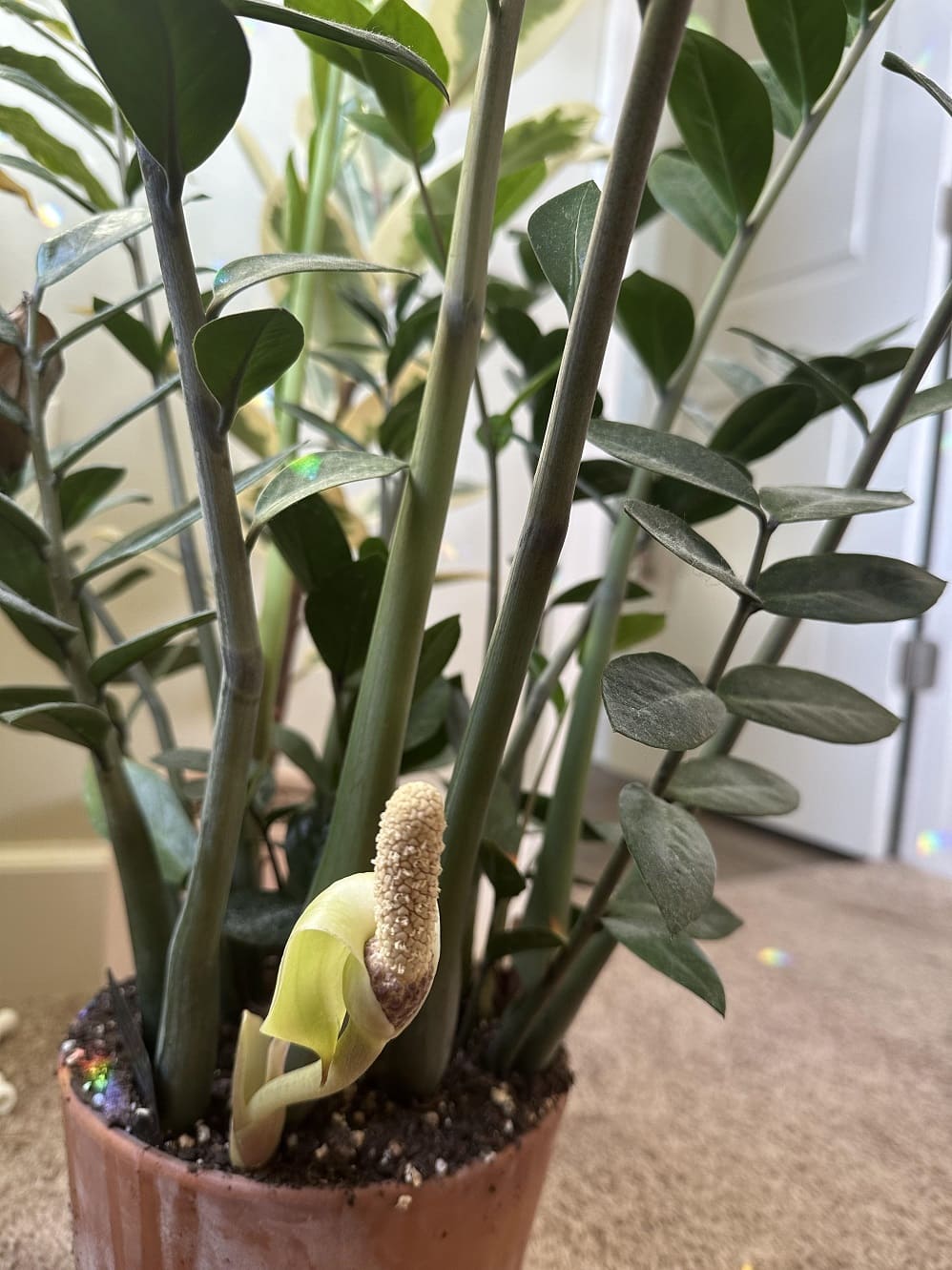
The flowers are designed to attract ground-dwelling pollinators like beetles or ants, which explains why they appear low to the ground rather than prominently displayed like many other flowering houseplants.
Debunking Common Myths
Let me address some persistent misconceptions I’ve encountered in my years of growing ZZ plants:
- Myth 1: “ZZ plants are desert plants that never need water”; Reality: While drought-tolerant, ZZ plants actually prefer regular watering during their growing season, followed by drier periods—mimicking their natural rainfall patterns.
- Myth 2: “They cause cancer or are extremely poisonous”; Reality: Like many houseplants, ZZ plants contain calcium oxalate crystals that can cause mouth irritation if consumed, but they’re not more dangerous than common vegetables like spinach or cabbage that contain the same compounds. The cancer claims are completely unfounded internet rumors with no scientific basis.
- Myth 3: “ZZ plants don’t need light”; Reality: While remarkably tolerant of low light, they actually grow faster and develop stronger, more upright growth in bright, indirect light.
- Myth 4: “ZZ plants should never be watered”; Reality: This harmful misconception leads to plants going dormant and losing all their leaves. ZZ plants actually need regular watering during their growing season, just with complete dry-out periods between waterings.
- Myth 5: “The pot becomes poisonous after housing a ZZ plant”; Reality: This is another baseless internet rumor. Pots can be safely reused for any other plants after housing a ZZ plant.
Exploring ZZ Plant Varieties: Finding Your Perfect Match
The Classic Beauty: Standard ZZ Plant
The original green variety remains the most popular choice, featuring thick, upright stems adorned with glossy, oval-shaped leaflets. This variety typically reaches 2-4 feet in height and offers the most robust growth and easiest care.
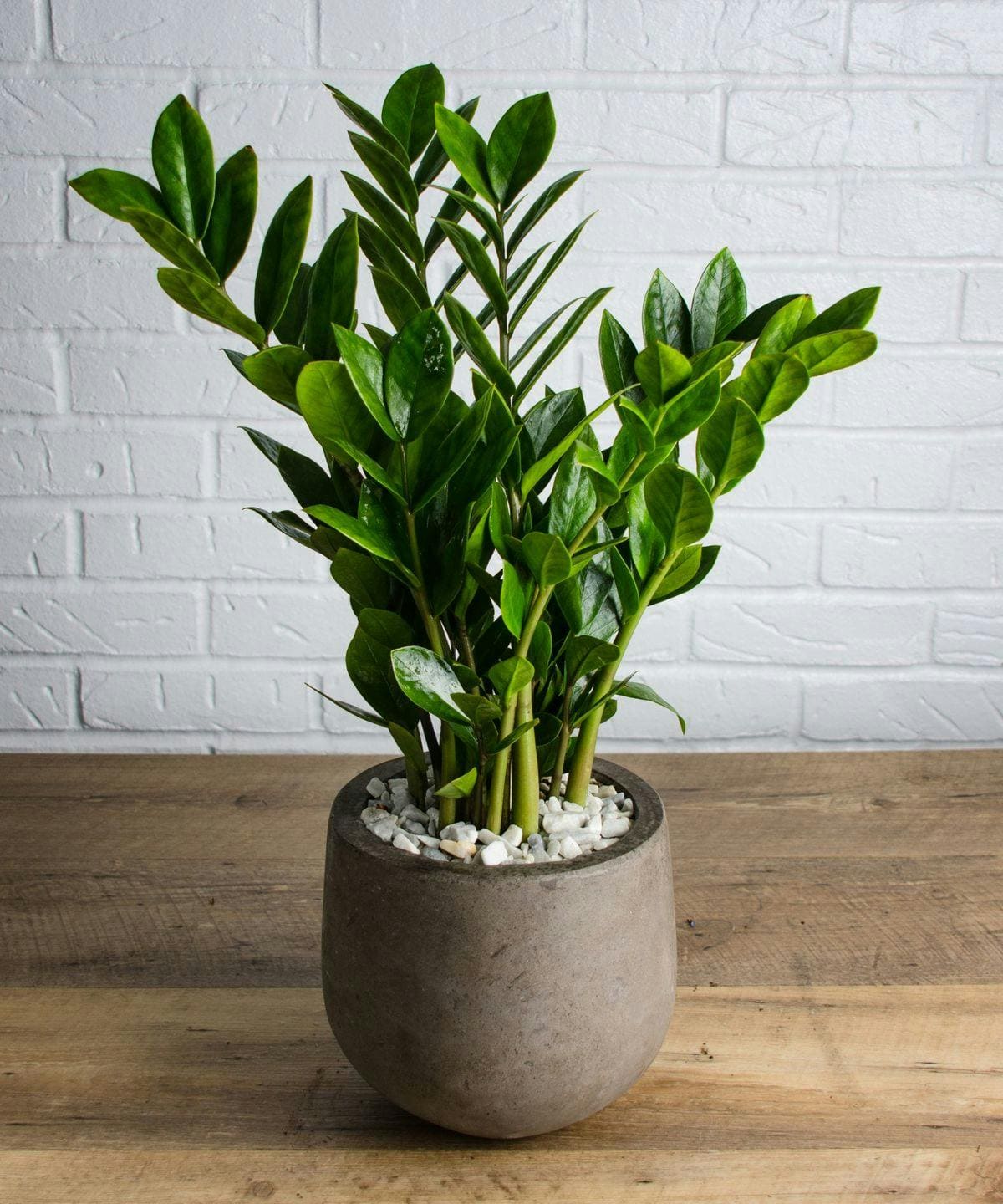
The Dramatic Statement: ZZ ‘Raven’
I remember the first time I saw a ‘Raven’ ZZ plant—the deep purple-black foliage was so striking I initially thought it was artificial.
This stunning variety starts with bright green new growth that gradually darkens to an almost black hue as it matures. While slightly more compact and slower-growing than the standard variety, ‘Raven’ makes an incredible statement piece.
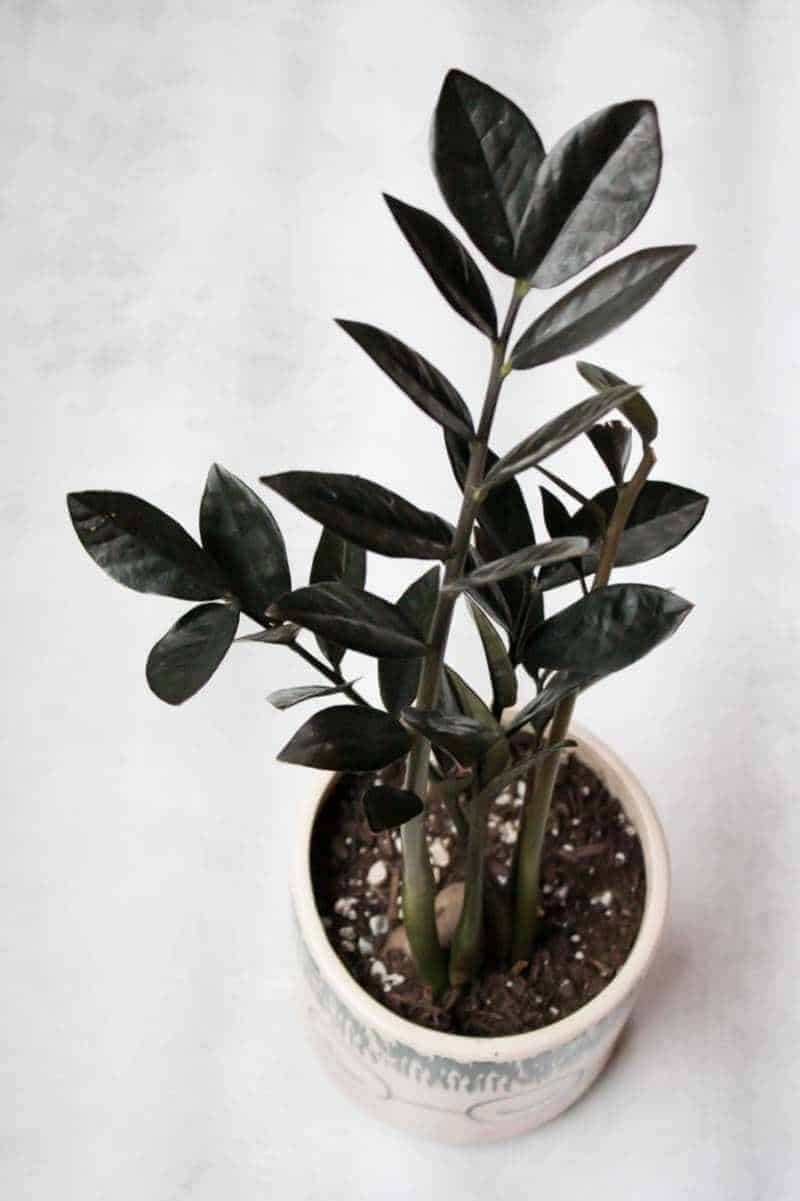
The Space-Savers: ZZ ‘Zenzi’ and ‘Zamicro’
Perfect for smaller spaces, these dwarf varieties maintain the classic ZZ appearance in a more compact form. ‘Zenzi’ features tightly packed, slightly curved leaves on thick stems, while ‘Zamicro’ offers a more slender leaf shape, both staying under 2 feet tall.

The Rare Beauty: Variegated ZZ
The holy grail for many collectors, variegated ZZ plants feature cream and green markings on their leaves. However, be prepared for a significant investment and understand that variegation may fade in low-light conditions.

The Complete ZZ Plant Care Methodology
Mastering the Light Game
Optimal Placement Strategy:
- Best case scenario: Bright, indirect light from east or north-facing windows
- Acceptable alternative: 3-6 feet from a south or west-facing window
- Survival mode: Low-light corners or fluorescent office lighting
In my own collection, I’ve noticed that ZZ plants in brighter locations produce new growth every 6-8 weeks during the growing season, while those in lower light may go 3-4 months between new shoots. Both are healthy—it’s simply a matter of growth rate preference.
Warning signs of light issues:
- Leggy, stretched growth = insufficient light
- Scorched, yellowing leaves = too much direct sun
- Extremely slow or no growth = needs more light for optimal health
Read the Monstera Standleyana Care Guide: Tips for a Thriving Philodendron Cobra Plant
The Art of Watering: Less is Definitely More
The ZZ Plant Watering Formula:
- Check the soil: Insert your finger 2-3 inches deep into the soil
- Wait for complete dryness: The soil should be dry throughout, not just on top
- Water thoroughly: When watering, soak until water drains from the bottom
- Empty drainage trays: Never let the plant sit in standing water
Advanced Watering Technique for Very Dry Soil: When soil becomes extremely dry (with visible cracks and pulling away from pot edges), don’t water all at once. Instead, water in small batches, allowing each to absorb before adding more. This prevents water from simply running through without moistening the root zone.
Seasonal Watering Schedule:
- Spring/Summer (growing season): Every 2-3 weeks, depending on light and temperature
- Fall/Winter (dormant season): Every 4-6 weeks, sometimes longer
I’ve learned this lesson the hard way: I once killed a thriving ZZ plant by “kindly” watering it weekly during winter. The lesson? Trust the plant’s natural rhythms over your human instinct to nurture through frequent watering.
Managing Natural Growth Patterns
Understanding Plant Behavior: ZZ plants naturally lean toward their light source, which can create an “untidy” appearance over time. This is completely normal behavior, not a sign of poor health. To maintain a balanced appearance:
- Rotate your plant a quarter turn every few weeks
- Move plants closer to light sources if leaning becomes excessive
- Use decorative stakes for support if needed, though this typically isn’t necessary
Soil Composition: The Foundation of Success
The Perfect ZZ Plant Soil Recipe:
- 50% quality potting mix
- 25% coarse sand or perlite
- 15% orchid bark or pumice
- 10% coarse perlite or lava rock
This mixture provides excellent drainage while retaining just enough moisture for healthy root development. Avoid heavy, moisture-retaining soils at all costs—they’re the fastest way to kill a ZZ plant through root rot.
Environmental Maintenance
Leaf Care and Cleaning: ZZ plant leaves naturally accumulate dust, which can dull their signature glossy appearance and reduce their ability to photosynthesize effectively.
Proper cleaning technique:
- Use a damp, soft cloth to gently wipe each leaf
- For thorough cleaning, place the entire plant in a tepid shower and rinse gently
- Never use commercial leaf shine products—these can clog the plant’s pores and cause more harm than good
- Occasional light misting can help reduce dust buildup, though it’s not necessary for humidity
The natural waxy coating will restore the leaves’ glossy appearance once properly cleaned.
Here’s How to Identify and Fix Brown Spots on Your Snake Plant
Temperature and Environmental Needs
ZZ plants thrive in typical household conditions:
- Ideal temperature range: 65-85°F (18-30°C)
- Minimum tolerance: Don’t let temperatures drop below 50°F (10°C)
- Humidity requirements: Average household humidity (40-50%) is perfect
- Air circulation: Ensure good ventilation to prevent fungal issues
Fertilizing: The Minimalist Approach
Annual Feeding Schedule:
- Spring: One application of balanced, diluted liquid fertilizer
- Mid-summer: Optional second feeding if growth is desired
- Fall/Winter: No fertilization needed
Over the years, I’ve found that ZZ plants are like that friend who’s perfectly content with minimal attention—they actually perform better when you don’t try too hard to pamper them.
Propagation Mastery: Multiplying Your ZZ Plant Family
Method 1: Division (Fastest Results)
- Timeline: Immediate new plants
- Success Rate: Nearly 100%
- Best time: During repotting in spring
Step-by-step process:
- Remove the plant from its pot and gently clean excess soil from roots
- Identify natural separation points in the rhizome system
- Using a clean, sharp knife, cut through rhizomes ensuring each section has both roots and shoots
- Allow cut surfaces to dry for 24 hours to prevent rot
- Plant each division in appropriate soil mix

Method 2: Leaf Cuttings (The Patient Gardener’s Choice)
- Timeline: 6-12 months for visible results
- Success Rate: 70-80% with proper technique
- Best time: Spring through early fall
Detailed propagation process:
- Select healthy, mature leaves from the plant
- Cut leaves with a portion of the stem (petiole) attached
- Allow cuttings to callous for 24-48 hours in open air
- Plant in well-draining soil with only the cut end buried
- Place in bright, indirect light and water sparingly
- Watch for small tubers to develop at the base over several months

I started my first leaf cutting propagation experiment with six leaves. Four months later, I was convinced I’d failed—all the leaves had died back to just small nubs in the soil. But I kept the pots, and eight months later, tiny new shoots emerged from what I thought was failure. Patience truly is essential with ZZ plant propagation.
Method 3: Stem Cuttings in Water
- Timeline: 2-4 months to develop substantial roots
- Success Rate: 60-70%
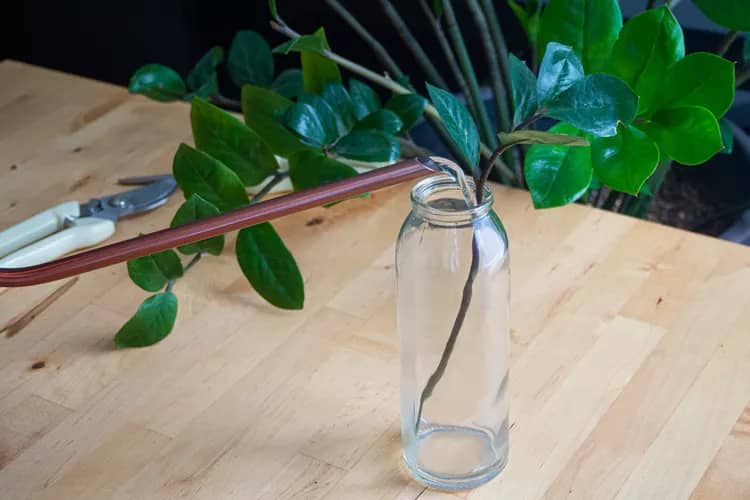
This method involves placing entire stems in water until roots develop, then transplanting to soil. While slower than division, it’s fascinating to watch the root development process.
Here’s How to Use Honey as a Natural Rooting Hormone for Cuttings
Smart Shopping: Selecting the Perfect ZZ Plant
In-Store Buying Tips
When purchasing a ZZ plant, these inspection points will ensure you bring home a healthy specimen:
Pest Inspection Checklist:
- Look for spots, discoloration, or sticky residue on leaves
- Check for flying insects around the soil surface
- Examine the undersides of leaves for webbing or small pests
- Avoid plants with visible pest damage
Root Health Assessment:
- Gently lift the plant to check drainage holes
- Healthy roots should be light-colored, not black or mushy
- Avoid plants with excessive roots growing from drainage holes (severely root-bound)
- The plant shouldn’t be loose or wobbly in its pot
Overall Plant Evaluation:
- Choose plants with upright, firm stems
- Glossy, unblemished leaves indicate good health
- Read plant labels carefully to understand specific variety care requirements
- Consider buying larger plants if you want immediate impact, as ZZ plants are naturally slow growers
Styling and Placement: Making Your ZZ Plant Shine
Creating the Perfect Environment
Living Room Placement:
- Floor plants in decorative baskets for larger specimens
- Console table centerpieces for medium-sized plants
- Grouped with other low-light plants for a lush corner display
Office Integration:
- Desk companions that tolerate fluorescent lighting
- Reception area statement pieces requiring minimal care
- Conference room plants that maintain professional appearance
Bedroom Sanctuary:
- Low-light tolerant bedside plants
- Corner arrangements that improve air quality
- Dresser top displays in decorative containers
Container Guidelines
Pot Selection Essentials:
- Always choose pots with drainage holes
- Select containers 1-2 inches larger than the root ball
- Consider ceramic or terracotta for better breathability (ZZ plant roots can be strong enough to crack weaker containers)
- Avoid decorative pots without drainage unless used as cachepots
- Pro tip: Transparent orchid pots provide superior drainage and airflow around roots, significantly reducing root rot risk
Understanding Pot Distortion: Don’t panic if your ZZ plant’s pot begins to bulge or warp—this is completely normal! The thick rhizomes can push against container walls as they grow, and this isn’t cause for concern unless the pot actually cracks or splits. This is another reason why sturdy ceramic containers are preferred over thin plastic pots.
I’ve found that ZZ plants look particularly striking in modern, minimalist planters that complement their architectural foliage. A simple white ceramic pot allows the plant’s dramatic form to take center stage.
Here’s How to Grow and Care for Pot Mums: A Comprehensive Guide
Comprehensive Troubleshooting Guide
Yellow Leaves: Decoding the Message
- Natural aging: Bottom leaves yellowing one at a time = normal plant behavior
- Overwatering: Multiple leaves yellowing simultaneously + mushy stems = reduce watering immediately
- Underwatering: Widespread yellowing + wrinkled stems = increase watering frequency
- Light stress: Yellow leaves with brown edges = move away from direct sun
Find out Why Are Your Cucumber Leaves Turning Yellow? Top Causes & Solutions
Root Rot: Prevention and Treatment
Prevention strategies:
- Use well-draining soil exclusively
- Ensure proper drainage in all containers
- Water only when soil is completely dry
- Provide adequate air circulation
Treatment protocol if caught early:
- Remove plant from pot immediately
- Rinse roots thoroughly and examine for damage
- Cut away any black, mushy, or damaged roots with sterile tools
- Allow plant to dry for 24 hours before repotting
- Repot in fresh, well-draining soil
- Withhold water for 2-3 weeks to allow healing
Pest Management
While ZZ plants are relatively pest-resistant, they can occasionally attract:
- Spider mites: Fine webbing on leaves, treat with neem oil
- Mealybugs: White, cottony clusters, remove with alcohol-soaked cotton swabs
- Aphids: Small, soft-bodied insects, treat with insecticidal soap
In five years of growing ZZ plants, I’ve encountered pests only twice—both times on plants that were stressed from overwatering. Healthy ZZ plants seem to have natural pest resistance.
Read The Beginner’s Guide To Attracting Ladybugs To Your Garden
Understanding Dormancy Periods
ZZ plants may enter dormancy during winter or periods of stress, during which they:
- Stop producing new growth
- May drop some older leaves
- Require even less water
- Appear to “do nothing” for months
This is completely normal behavior, not a sign of plant distress. Maintain minimal care and wait for spring growth to resume.
Repotting and Long-term Plant Care
When to Repot
- Every 2-3 years for mature plants
- When roots are visibly circling the pot
- If plant becomes top-heavy and unstable
- When soil remains wet for extended periods
The Repotting Process
- Preparation: Water plant 24 hours before repotting to reduce transplant shock
- Gentle removal: Carefully remove plant from current container
- Root inspection: Check for signs of rot or damage
- Size selection: Choose a pot only 1-2 inches larger than previous
- Fresh soil: Use completely new, well-draining soil mixture
- Post-repotting care: Wait 1-2 weeks before watering
Safety Considerations and Household Integration
Toxicity Information
ZZ plants contain calcium oxalate crystals that can cause:
- Mouth and throat irritation if consumed
- Potential skin irritation in sensitive individuals
- Discomfort for pets if chewed or eaten
Safety Measures
- Keep plants out of reach of small children and pets
- Wear gloves when handling during repotting or propagation
- Wash hands thoroughly after plant contact
- Consider placement in rooms where pets don’t typically access plants
As a pet owner, I’ve found that placing ZZ plants on higher surfaces or in rooms where my cats don’t spend time eliminates any safety concerns while still allowing me to enjoy these beautiful plants throughout my home.
Here’s How to Design a Garden That Your Cat Will Love: Essential Tips and Ideas
Frequently Asked Questions
- How long can a ZZ plant go without water?
ZZ plants can survive 1-3 months without water, depending on environmental conditions, plant size, and season. However, for optimal health and growth, water when the soil is completely dry, typically every 2-6 weeks.
- Why isn’t my ZZ plant growing?
ZZ plants are naturally slow growers, producing only 1-4 new shoots per year. If your plant shows no growth for over a year, consider increasing light exposure, checking for root boundedness, or providing diluted fertilizer during the growing season.
- Can ZZ plants survive in offices with only fluorescent lighting?
Yes, ZZ plants are among the best choices for office environments with artificial lighting. While growth will be slower than in natural light, they can maintain their health and appearance under fluorescent bulbs indefinitely.
- How do I know if my ZZ plant is healthy?
A healthy ZZ plant displays firm, upright stems, glossy green leaves (or appropriate color for variety), and produces occasional new growth during the growing season. The soil should dry completely between waterings without the plant showing stress.
- Is it normal for ZZ plants to lose leaves?
Yes, ZZ plants naturally shed older leaves as part of their growth cycle. This is especially common during seasonal transitions or when the plant redirects energy to new growth. Only be concerned if multiple leaves yellow simultaneously, which usually indicates watering issues.
- Does a ZZ plant clean the air?
Yes, ZZ plants are excellent air purifiers that remove toxins like xylene, toluene, and benzene from indoor environments, making them both beautiful and functional houseplants.
- Should I mist my ZZ plant?
Misting is unnecessary for ZZ plants, as they’re adapted to dry conditions and store water in their rhizomes. Focus on proper watering when soil is dry rather than increasing humidity through misting.
Embracing the ZZ Plant Lifestyle
After years of growing and observing ZZ plants, I’ve come to appreciate their unique rhythm and philosophy. They’ve taught me that sometimes the most beautiful relationships—whether with plants or people—thrive on mutual respect rather than constant attention.
My ZZ plants sit quietly in their corners, requiring little from me but offering so much in return: clean air, natural beauty, and the satisfaction of caring for something truly resilient.
The ZZ plant represents a perfect introduction to the world of houseplants for beginners while remaining a cherished favorite among experienced plant parents. Its combination of stunning architectural beauty, remarkable resilience, and minimal care requirements makes it an ideal choice for anyone looking to bring a touch of nature indoors.
Whether you’re furnishing your first apartment, adding life to a challenging office space, or expanding an existing plant collection, the ZZ plant offers the rare combination of high impact and low maintenance.
In a world where we’re often overwhelmed by things requiring constant attention, the ZZ plant stands as a green reminder that sometimes the best companions are those that give us space to breathe while quietly enriching our environment.
Ready to welcome a ZZ plant into your space? Start with a classic green variety, place it in bright, indirect light, water it thoroughly but infrequently, and prepare to enjoy one of the most rewarding plant relationships you’ll ever cultivate. Your future self—and your ZZ plant—will thank you for choosing this remarkable, nearly indestructible green companion.
